Center Points
Field Day: Research for the Land and Its People
Our annual Field Day will return to an in-person experience! Hosting an outdoor event has definite advantages this summer as we return to a new normal.
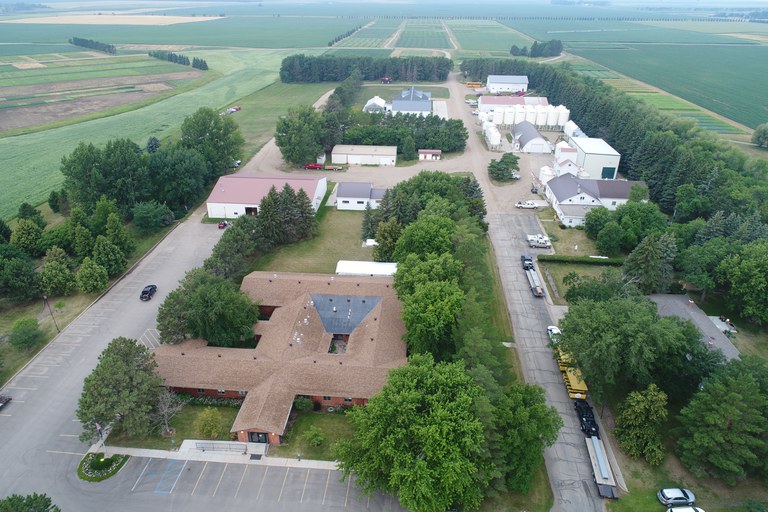 Quiet expectation. This UAV photo of an empty yard tour trailers was taken at 7:15 a.m. on a prior CREC Field Day.
Quiet expectation. This UAV photo of an empty yard tour trailers was taken at 7:15 a.m. on a prior CREC Field Day.
We welcome you to join us on Tuesday, July 20, for an informative look at the research and work conducted at the NDSU Carrington Research Extension Center. If you’ve attended past Field Days, you’ll find our plans familiar. If this will be your first Field Day experience, we hope you enjoy your visit.
We’ll start the day at 9:00 a.m. with coffee, juice, and donuts.
NDSU Vice President for Agricultural Affairs Greg Lardy and a representative from the ND State Board of Agricultural Research and Education, along with CREC Director Blaine Schatz, will share comments and provide direction for the day. We’ll have extra wagons available to transport guests to any of our four morning tours, but individuals are welcome to travel in private vehicles, if desired.
Our most popular tour, Agronomy Research, splits into two groups but covers the same stops. Our agronomy tour will visit spring wheat, canola, corn, soybean, and dry bean plots to discuss variety trial performance and this year’s research efforts.
Our Livestock Unit will answer this year’s pressing issue, looking at drought topics specifically related to drylot cattle. Research updates will be provided.
In our orchard, guests can participate in a tour of the various fruit trees and bushes that tolerate and thrive in North Dakota’s northern climate.
Ancient grains, wheat flax intercropping, buckwheat and other cereal grain crops will be featured in this year’s organic and sustainable agriculture tour.
Morning tours start at 9:30 a.m. and return to our yard at noon for lunch.
Because we’ll need a little extra time (and space) this year to serve lunch safely, we’re going to schedule the return from each tour to provide better service, and we’ve added a few features to our noon break. We’ll pull some of our plot equipment into a viewing area with technicians on hand to answer questions about the features specific to plot-scale equipment. We’ll also have displays to test your knowledge of North Dakota’s wide range of food, feed, fuel, and fiber; and we’ll have an “Ask an Expert” booth on site.
There is a second agronomy tour in the afternoon, looking at precision agriculture topics including robotics, dry bean disease and remediation, and weed science.
Participation in this activity/event is voluntary. NDSU Agriculture will take reasonable measures but cannot assure participants are protected from coronavirus and similar exposures.
Linda Schuster
Linda.Schuster@ndsu.edu
Administrative Secretary
Extension Hosting Manure Composting Workshop at CREC
North Dakota State University Extension, in conjunction with the University of Minnesota Extension, is hosting two in-person manure composting workshops.
The workshops will be on July 21 at the NDSU Carrington Research Extension Center in Carrington, N.D., and on Aug. 11 at the UMN West Central Research and Outreach Center in Morris, Minn.
Workshops will begin at 8 a.m. and conclude at 4:30 p.m. Central time.
This workshop, sponsored by the North Central Region Sustainable Agriculture Research and Education program, will focus on the basics of turning raw manure into compost. Compost producers who make up the producer panel will be available to answer questions throughout the day at each workshop.
Topics for the workshops include:
- Site selection
- Temperature management
- Moisture management
- Turning the compost
- Spreader calibration demonstration
- Sampling demonstration
- Understanding analysis reports
- Economics
- Regulations
- Q and A with expert compost producer panel
This workshop will provide a chance for people who have questions to learn the process of composting. They also will have a hands-on opportunity to practice various management techniques they may need to use when making their own compost in a low-stress environment.
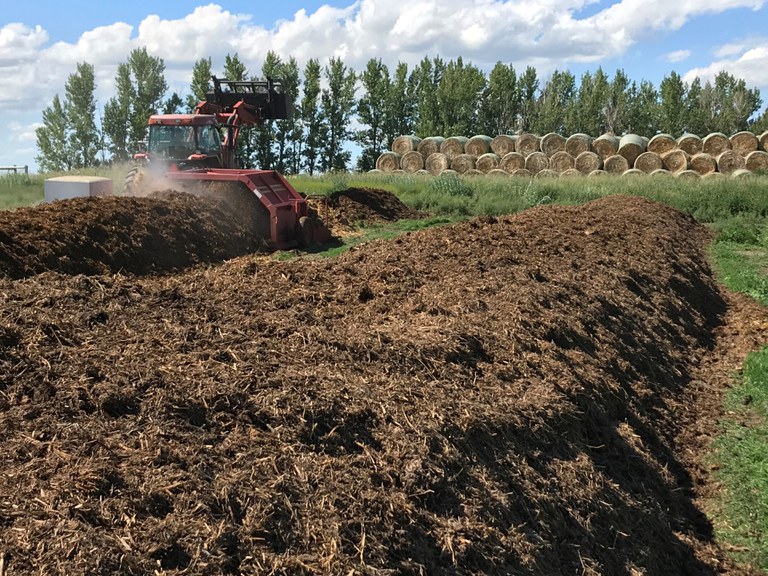 Turning compost is an essential step for maintaining proper temperature during the decomposition process.
Turning compost is an essential step for maintaining proper temperature during the decomposition process.
Registration is free but required. Go to https://z.umn.edu/Compost2021 to register. The registration deadline for the North Dakota workshop is July 14. The registration deadline for the Minnesota workshop is Aug. 4.
For more information, email mary.keena@ndsu.edu or cmodderm@umn.edu.
Thank you to Jeff Gale, Foster County Agriculture and Natural Resources Extension agent, for co-facilitating the North Dakota event.
Mary Keena
Mary.Keena@ndsu.edu
Extension Livestock Environmental Management Specialist
Cover Crop Considerations for Dry Conditions
Cover crops can offer a number of benefits to a cropping system including increased biodiversity, crop/livestock integration, erosion control, or water management. One of the greatest risks to cover cropping is failure to establish, and in North Dakota that often is the result of insufficient moisture. What can be done to reduce the risk of cover cropping?
At a glance, cover cropping is often considered to be a fall activity. Following wheat, barley, or another short season crop, a cover crop is planted which will terminate when at freeze-up later in the fall. This is often a 2-3 month window of ‘fallow’ time for a field, making it a convenient option for cover crops. Several recent falls have highlighted some of the largest challenges for cover cropping. For instance, in 2020 and 2018 conditions were very dry and poor emergence occurred. In 2019, there was much more moisture, but the temperature was cool enough to reduce the growth and resulted in small, unimpressive cover crops. Are there any alternatives?
One practice that is trending upward is planting cover crops earlier, often into corn crops. There has been a lot of hype about 60” corn rows, which is very cover crop friendly. However, even on standard row spacings cover crops can provide value, particularly if they are direct seeded (rather than broadcast). Planting the cover crop in mid-June or early July into corn has translated to high establishment success over the last three years at CREC. This overcomes the production barriers of limited growing season and rainfall. However, do note that the narrower the corn row, the less biomass will be produced.
With a mid-summer planting date, a wide range of cover crop species are viable. Plus, weed management isn’t sacrificed as many cover crop species are compatible with a number of corn herbicides (check labels if the intent is to graze the cover crop).
Some new machines assist with interseeding cover crops into corn, but it is also possible to interseed with existing or older equipment. We converted a 71 JD Flex planter into a three-point mounted unit specifically to plant between corn rows (Figure 1). This option has provided good establishment, even with cover crop blends (Figure 2).
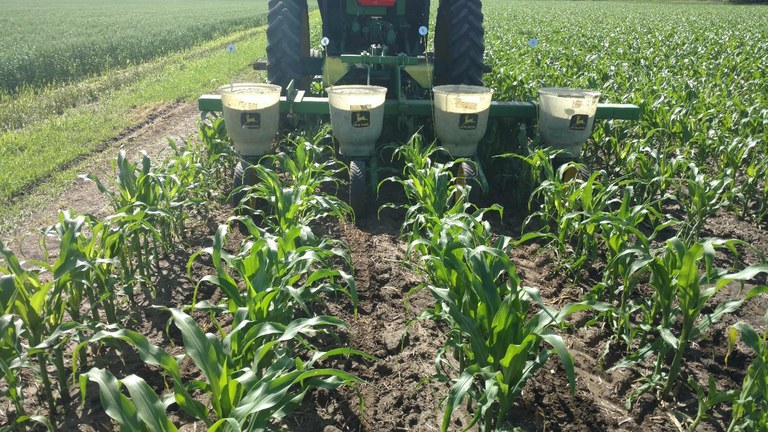 Figure 1. Planting cover crops into V5 corn on July 1 2019.
Figure 1. Planting cover crops into V5 corn on July 1 2019.
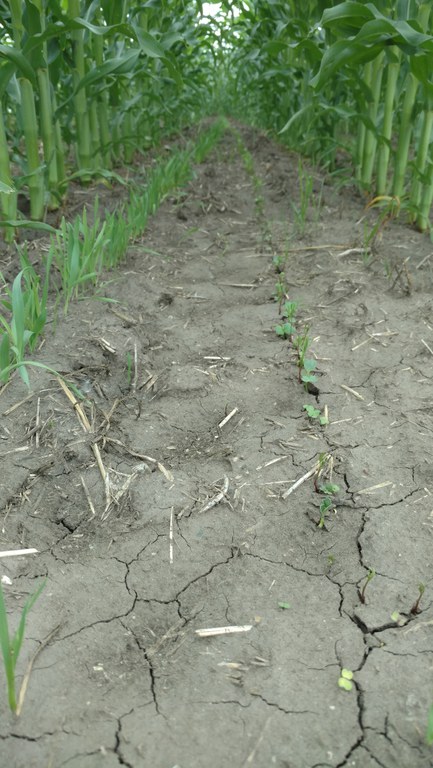 Figure 2. Cover crops emerging following the planting in Figure 1.
Figure 2. Cover crops emerging following the planting in Figure 1.
Our primary goal has been to grow cover crops for grazing. While doing this, corn cover cropping has delivered much better outcomes over the last three years compared to a small grain to cover crop relay.
NDSU does not endorse commercial products or companies even though reference may be made to tradenames, trademarks or service names.
Mike Ostlie, Ph. D.
Mike.Ostlie@ndsu.edu
Research Agronomist
Searching for Feeds
Cattle producers are being challenged to find feed for their cow herd. Drought has placed a terrible constraint on feed resources, causing extra hay, normally saved for next season, to be currently fed or already consumed.
It’s a double hit. Reduced pasture growth means feeding more harvested feed before pasture turn out AND fields that are normally hayed are not growing. Consequently, next year’s winter feed supply is looking sparse.
Unless a total drought occurs, there will be some feed produced this summer. It may have been intended as forage, or perhaps a failed field crop. Instead of harvesting for grain, fields can be hayed or made into silage. Drought raised feeds should have their nutritional profile tested before feeding, looking for both nutrient and toxin levels.
Cereal grains such as wheat, barley or oats, can be hayed and make excellent feeds for a cow herd. With normal rainfall, 3 to 6 large round bales per acre could be harvested. During drought, though, only 1 or 2 bales per acre may be realized.
Be sure to test for nitrates. If toxic levels are found, feed can be diluted with low nitrate feeds when fed. Making silage from these feeds will reduce the nitrate concentration by 50% as the microbes digest nitrates during the fermentation process.
Corn silage is an excellent winter cow feed. In June, the corn is still actively growing and we don’t know what the yield will be. From a cow herd perspective, we might have to buy more corn acres to chop, probably not a cheap source of feed with higher corn prices forecasted. However, it is a source of feed. Corn silage doesn’t lend itself to hauling distances, though, with a 65% water content.
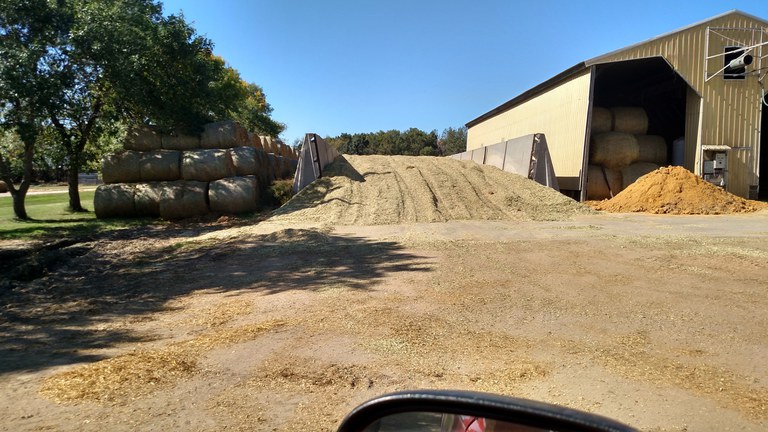 Corn silage is excellent winter feed.
Corn silage is excellent winter feed.
Drought may be widespread in North Dakota but not across the USA. Feeds can be shipped into North Dakota. Please monitor carefully for noxious weeds that could be in feeds. Shipping screenings from another state in to North Dakota could contribute to palmer amaranth or other weed invasion.
North Dakota processing plants produce co-products like wheat midds, distiller grains, soy hulls, corn gluten feed, barley hulls, pea splits, screenings and many protein sources. A list of co products produced in North Dakota is available at https://www.ag.ndsu.edu/livestockextension/sources-and-prices-for-selected-co-products-produced-in-north-dakota.
North Dakota feed manufacturers provide an abundant source of supplements and complete feeds. When in a drought and feed prices are high, feed manufacturers can still produce a reasonably priced feed. These feeds make a balanced ration with added protein, energy, vitamins, minerals and additives. Manufactured feeds can be at a lower cost than the combined cost of buying each ingredient separately.
If you need to discuss options, please contact me or your local NDSU Extension Ag and Natural Resources Agent; we’re here to help.
Karl Hoppe, Ph. D.
Karl.Hoppe@ndsu.edu
Extension Livestock Specialist
Durum Day at CREC on June 29
Farmers and crop advisers are invited to attend the Durum Day scheduled at the NDSU Carrington Research Extension Center (CREC) on Tuesday, June 29 from 10:00 a.m. to 2:00 p.m. The program is being developed and delivered through the cooperative efforts of Dakota Growers Pasta/8th Ave and the CREC. The objective of the event is to provide updates on durum production, grain quality and markets for established, as well as, potential durum growers.
The event’s agenda includes presentations by NDSU and industry representatives during field tours of research trials and surrounding a sponsored noon lunch. Durum topics include:
- Variety performance
- Plant nutrition
- Disease management
- Grain quality and impact on pasta quality
- Market outlook
- Pasta industry insights and impact on farmers
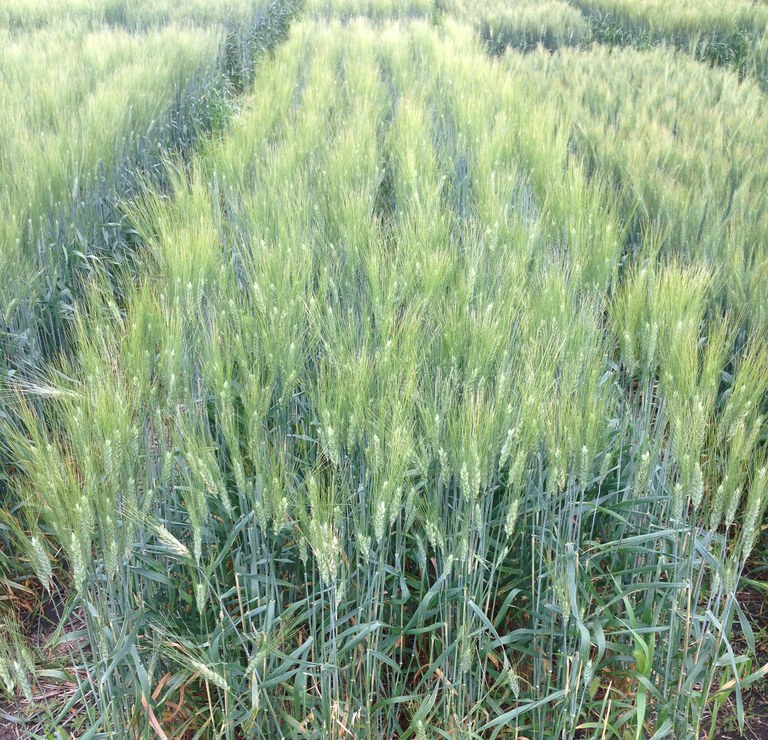 Durum varieties will be discussed at Durum Day.
Durum varieties will be discussed at Durum Day.
Event details may be obtained by contacting Dakota Growers Pasta/8th Ave (cole.hanson@8ave.com; 701.652.4804) or the CREC (www.ag.ndsu.edu/CarringtonREC; 701.652.2951).
Greg Endres
Gregory.Endres@ndsu.edu
Extension Agronomist
Sacrifice Area May Save Grazing Resources
During dry conditions, establishing a sacrifice area may help prevent livestock from overgrazing and damaging a small farm’s grazing resources. Overgrazing can lead to weed overgrowth and ultimately will be time consuming and costly to re-establish grass in the future.
A sacrifice area is an area where animals stay at times when pasture grazing is detrimental to land and plants. This area can be in a dry lot pen or a fenced-off area of the pasture. This can be during times that animals do not need to graze or dormant seasons, drought times or periods of excess moisture.
The goal of these areas is to sacrifice a small part of your resources to ensure the majority of your land has the rest it needs to stay healthy and productive.
To establish a sacrifice area, keep the following factors in mind:
- Location - Where you will store manure in relation to surface and groundwater?
- Soil characteristics and structure - Will the soil type be able to withstand continuous hoof action? Does the site drain water well? Where does water flow after a large rain event?
- Ease of use - Where is the sacrifice area relative to the water source, food storage and manure storage areas?
- Manure collection - Collecting manure and moving it out of the dry lot area will help reduce fly infestations. Where is the manure storage area relative to the sacrifice area? If you think long term, how will you manage the manure storage area? Will you compost the manure or will you spread it raw? If you plan to spread the manure as raw material on a pasture, it is recommended you spread a thin layer and refrain from grazing that area so hot weather can disrupt the parasite life cycle. If you plan to spread the manure, will you do it or will you hire a custom applicator? When hiring a custom applicator, do you have the land to spread the manure on and is your manure storage area large enough for their equipment?
- Fly control - How will you manage for external parasites such as flies? Flies lay their eggs in the top few inches of manure and they can hatch every seven days. By keeping your sacrifice area clean and turning manure piles in the storage area weekly, you can compost manure and stay ahead of the fly cycle.
- Space - Does your sacrifice area provide an adequate exercise area?
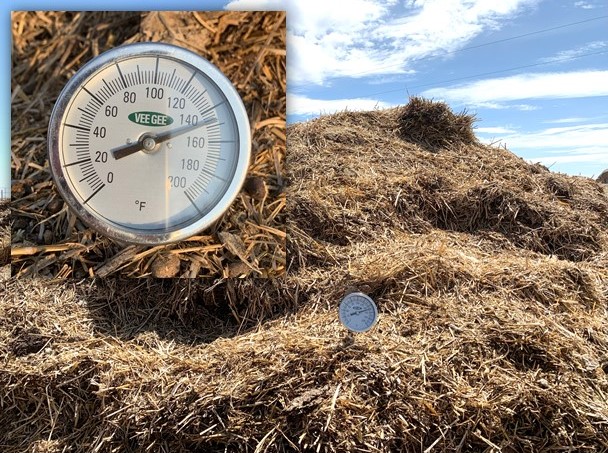 A manure pile from a dry lot is undergoing thermophilic decomposition with the temperature between 130 to 150 degrees Fahrenheit.
A manure pile from a dry lot is undergoing thermophilic decomposition with the temperature between 130 to 150 degrees Fahrenheit.
For those who are experiencing small-farm challenges or would like additional tips and information about grazing and manure management, call your local county NDSU Extension agent for resources and help to keep land healthy and productive. Visit https://www.ag.ndsu.edu/extension/directory/counties for contact information for county agents. A list of North Dakota custom manure applicators, an online composting workshop and the NDSU Extension Horse Management webinar series are available at https://www.ag.ndsu.edu/lem.
A special thank you to Penny Nester, Ag and Natural Resources agent in Kidder County for being a co-writer on this article.
Mary Keena
Mary.Keena@ndsu.edu
Extension Specialist/ Livestock Environmental Management
Selected CREC Tours for Summer 2021
Crop Management Field School
NDSU Extension’s annual Crop Management Field School will be conducted on June 10 at the CREC. Field sessions include:
*Weed identification - identify about 60 living weed exhibits, plus receive brief reviews on selected weed biology and control
*Herbicide site-of-action - identify herbicide classes by examining crop and weed injury symptoms
*Late-season wheat disease management - review crop stages and disease identification, plus the most effective use of fungicides to protect wheat seed yield and quality
*Low and high soil pH - challenges and management strategies
Registration is required at www.tinyurl.com/CRECstore .
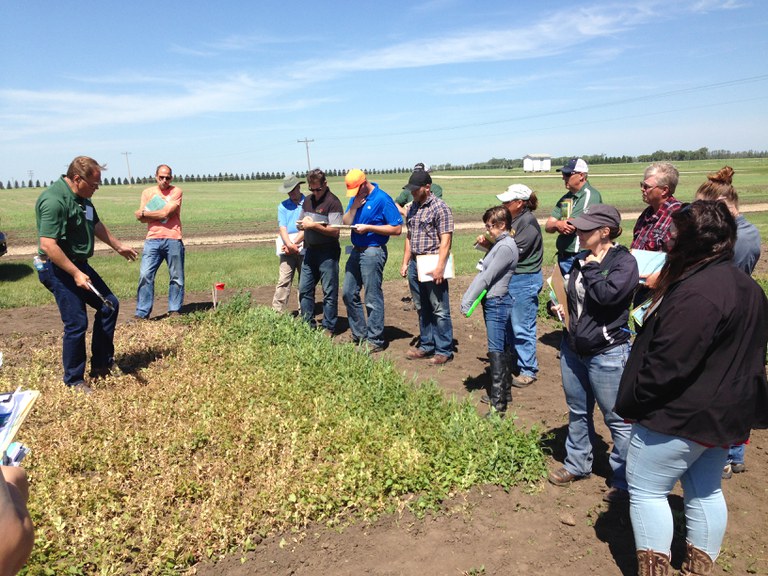 Participants at the NDSU Crop Management Field School receive hands-on instruction.
Participants at the NDSU Crop Management Field School receive hands-on instruction.
Durum Tour
The event scheduled for June 29 is cooperatively being planned and will be conducted with Dakota Growers Pasta Company. Field and lunch sessions include durum variety performance, plant nutrition, disease management, grain quality and market updates.
CREC Field Day
Our annual field day will be conducted on July 20. Two agronomy tours are being planned:
1. Spring wheat, canola, corn, soybean and dry bean (morning)
2. Precision ag, plant pathology, soil management and weed management (afternoon)
Our livestock tour will focus on drought decisions, especially related to drylot management.
An organic tour will look at ancient grains, wheat flax intercropping, and buckwheat production.
A tour of Northern Hardy Fruit Project will visit fruit trees that thrive in North Dakota’s climate.
Manure Composting Day
NDSU Extension is co-hosting two in-person manure composting workshops. Both days will focus on the basics of turning raw manure into compost. The Carrington day will be July 21, and a second tour will be held on August 11 at the UMN West Central Research and Outreach Center in Morris, Minn. Registration is free but required at https://z.umn.edu/Compost2021.
Row Crop Tour
The event will be conducted during late August (date to be determined). Corn, soybean, dry bean and sunflower production research and recommendations on plant establishment, nutrition and protection will be discussed while viewing selected research trials.
Greg Endres
Gregory.Endres@ndsu.edu
Extension Agronomist
Optimizing Fungicide Spray Droplet Size for Improved Disease Control and Yield
In the last few years, there has been significant discussion by private-sector and university agronomists on the importance of optimizing spray droplet size when applying herbicides. The discussion about spray droplet size has been focused nearly exclusively on herbicides, though, with little or no discussion about the impact of spray droplet size on the performance of other pesticides.
Does spray droplet size matter when applying fungicides? The standard recommendation is to apply fungicides with fine to medium droplets, but is that always true? Surprisingly, there is very little empirical data quantifying the impact of spray droplet size on fungicide performance on disease management in field crops.
The plant pathology research program in Carrington, in collaboration with the agronomists at the NDSU Robert Titus Research Farm in Oakes, has been conducting field studies to quantify the impact of spray droplet size on fungicide performance since 2017. Fungicide applications have been made with a tractor-mounted R&D sprayer equipped with a pulse-width modulation system from Capstan AG (Topeka, KS). Fungicides have been applied in a spray volume of 15 gal/ac and a driving speed of 4.0 mph, 6.0 mph, 6.7 mph, 8.9 mph, or 10.5 mph, depending on the study, with pulse width modified as needed to maintain a constant spray volume and constant driving speed across nozzles differing in output. Research has focused on management of white mold in soybeans and dry beans, Ascochyta blight of field peas, Ascochyta blight of chickpeas, and anthracnose of lentils.
The results indicate that fine to medium droplets do not always optimize fungicide performance. Fungicide droplet size must be calibrated relative to canopy characteristics, and significant yield gains can be achieved by optimizing fungicide spray droplet size.
For white mold in soybeans, optimizing fungicide spray droplet size relative to canopy characteristics increased the yield gain conferred by the fungicide by an average of 84%: optimizing fungicide droplet size nearly doubled the yield gain conferred by the fungicide. Fine to medium droplets optimized fungicide performance when the canopy was very open (average < 75% canopy closure when fungicides were applied); medium droplets optimized fungicide performance when the canopy was open (average 80-89% closure when fungicides were applied), and coarse droplets optimized fungicide performance when the canopy was at or near closure when fungicides were applied. A single application of the fungicide Endura (5.5 or 8.0 oz/ac) was applied at the R2 growth stage, and testing was conducted with TeeJet extended-range (XR) flat-fan nozzles. Parallel research conducted with Wilger Combo-Jet flat-fan nozzles conferred similar results.
The scatter plot below illustrates the impact of fungicide spray droplet size on white mold management in soybeans. Results are from field trials conducted in Oakes and Carrington from 2017 to 2020; circles denote the yield gain conferred by the fungicide in one replicated field study, and lines denote the average response across field studies. Testing was conducted on multiple soybean varieties differing in plant architecture and height. Average yield gains are presented together with letters denoting statistical separation (Tukey multiple comparison procedure; P < 0.05).
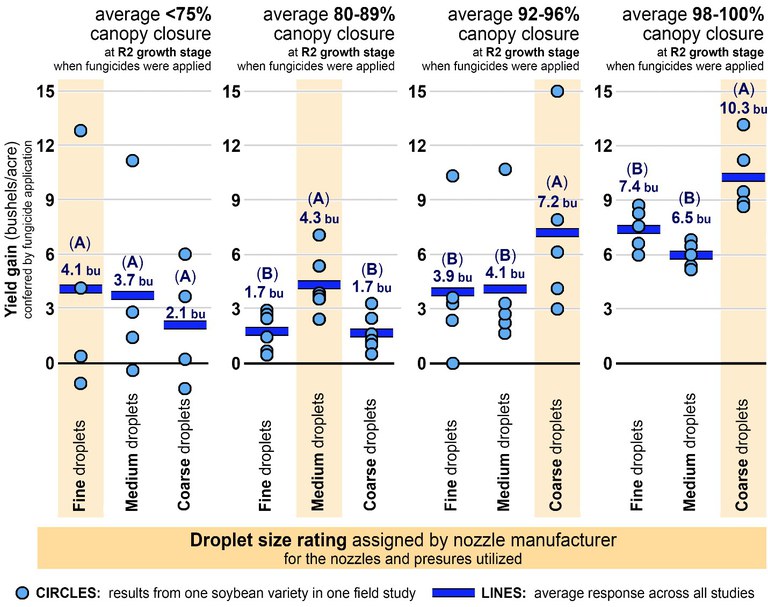 Impact of fungicide spray droplet size on white mold management in soybeans
Impact of fungicide spray droplet size on white mold management in soybeans
Similar results have been observed for white mold in dry beans. In testing conducted with the same droplet size applied in two sequential fungicide applications (at early bloom and 10-14 days later), fine droplets optimized fungicide performance when the canopy was still open when the second fungicide application was made; medium droplets optimized fungicide performance when the canopy was nearing closure at the second fungicide application; and coarse droplets optimized fungicide performance when the canopy was at/near closure at the second fungicide application. The scatter plot below summarizes results from studies conducted with TeeJet nozzles in 2017 to 2020. Testing was conducted with multiple varieties differing in plant architecture: ‘Palomino’, ‘Vibrant’, ‘Falcon’ and ‘Lariat’ pintos. The fungicide Endura (8 oz/ac) was applied in both applications or rotated with Topsin (40 fl oz/ac), depending on the study. Average yield gains are presented together with letters denoting statistical separation (Tukey multiple comparison procedure; P < 0.10). Similar results were observed in studies conducted with black and navy beans.
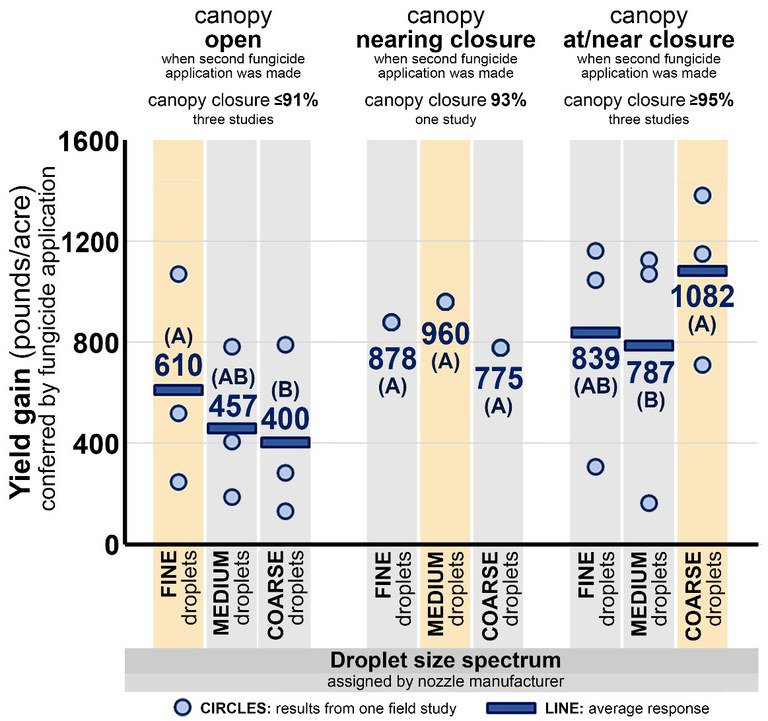 Canopy is a determining factor in droplet size for white mold management
Canopy is a determining factor in droplet size for white mold management
Additional yield gains from the fungicide can be expected in dry beans by calibrating fungicide spray droplet size relative to canopy characteristics at each fungicide application. Applying fine droplets at the first application (if the canopy is open) followed by coarse droplets at the second application (if the canopy is at or near closure) will almost certainly confer better disease control and higher yields than applying with the same droplet size twice. In field trials conducted in 2021, testing is being expanded to evaluate the impact of optimizing spray droplet size relative to canopy characteristics at each of the two fungicide applications (early bloom, 10-14 days later).
Results from droplet size research conducted on field peas, chickpeas, and lentils has produced similar results. When the targeted disease primarily impacts the upper canopy, fine droplets have optimized fungicide performance. When the targeted disease impacts the interior of the canopy, the optimum droplet size was contingent on canopy characteristics, with fine droplets optimal in an open canopy, medium droplets optimal in a canopy nearing closure, and coarse droplets optimal for applications made to a closed canopy. The only exception to this rule was observed with the use of chlorothalonil, which is an old contact fungicide that exhibits no systemic movement within plants. for chlorothalonil, preliminary results suggest that fine to medium droplets may optimize fungicide performance even when targeting a disease in the interior of a closed canopy. However, contact fungicides such as chlorothalonil are rarely used in field crops. The research conducted to-date indicates that for all of the modern fungicides, droplet size should be calibrated relative to location of the targeted tissues (top of the canopy versus interior of the canopy) and, for applications targeting the interior of the canopy, droplet size must be calibrated relative to canopy characteristics.
The results indicate that very high returns to investment can be achieved by optimizing droplet size for fungicides. Getting the spray droplet size right is cheap – only requiring proper nozzle selection and application pressure – and the optimal droplet size often confers yield gains of 50 to 100%. This research is ongoing, and results from the 2021 field season will be shown during the row crop tour at the end of the summer.
NDSU does not endorse commercial products or companies even though reference may be made to tradenames, trademarks or service names.
Michael Wunsch
Michael.Wunsch@ndsu.edu
Plant Pathologist
2021 Soil Fertility Trials at the Carrington REC
We have several soil fertility projects underway this season at the CREC. Let’s look at a few of them:
Comparative impact of biodegradable polymer-coated urea fertilizers on corn
Only a few effective slow-release nitrogen fertilizers (SRNFs) such as ESN (Environmentally Smart Nitrogen) exist on the market. ESN, however, sometimes releases N too slowly, missing synchronization of available N with crop needs. ESN polymer coating that protects urea granules from N loss usually persists in the soil for prolonged periods and is of some environmental concern. Field trials are testing the impact on corn performance of newly-developed soy-based coatings on SRNFs by Renuvix (Renuvix, LLC Fargo, ND).
Assess the impact of seed applied SRNFs during planting
Some farmers apply a blend of ESN and urea with seed during planting. This study tests what rates and formulation of the Renuvix SRNF can safely be applied simultaneously, compared with ESN, on dryland and irrigated wheat.
Assess the effectiveness of three nitrogen extender products that contain urease inhibitors
Urea fertilizers treated with NBPT (N-(n-butyl)thiophosphoric triamide) urease inhibitors like Agrotain, SuperU and ANVOL have been shown to reduce N loss from surface-applied urea fertilizer. Farmers have different preferences for these nitrogen extenders, and request them without knowing which particular product is being used. Because these treated fertilizers are more expensive than conventional urea, and they impact yields positively under specific environmental conditions, it is imperative to determine the most effective types. This trial compares products in wheat and corn.
 Fertilizer coatings in several colors.
Fertilizer coatings in several colors.
Jump starting mycorrhizal colonization in corn following non-host crop
Corn roots are hosts of beneficial mycorrhizal fungi upon which the crop depends to maximize nutrient uptake. Because the fungi population drops following non-host crops like canola or sugarbeet, field studies compare the impact of a host cover crop like rye, and seed-applied vesicular arbuscular mycorrhiza inoculant on corn yield and on the mycorrhizal fungi population following non-host crops.
Optimizing nitrogen and sulfur application strategies to improve canola production
High levels of available N in the soil can negatively impact canola yields if sulfur was deficient. Depending upon N levels, 15 lbs S can produce similar yields to 25 lbs S. Some research in Europe suggests that a onetime S application at bolting can be effective for increasing canola yields. Field trials will compare yield and quality with a single pre-plant application of S versus a single top-dress application at start of bolting. The trials also assess how yields vary with low and high N rates combined with low and high S rates.
Verifying corn response to mid-season N application based on crop canopy spectral reflectance
Current N fertilizer prices are over 50% higher than a year ago. Split application of N has been advocated as a means to improve N efficiency in corn production. Field studies will estimate the N needs of corn using crop spectral reflectance from light using the normalized difference vegetation index (NDVI). Plant height will be used in conjunction with NDVI to assess plant health.
NDSU does not endorse commercial products or companies even though reference may be made to tradenames, trademarks or service names.
If you have any questions about these projects or other soil matters, please contact me.
Jasper Teboh, Ph. D.
Jasper.Teboh@ndsu.edu
Soil Scientist
Extending the Usefulness of Yield Data to Across Field Profit Maps
Over the last couple of months, I have had several inquiries about profit maps, or rather, how to use yield data to produce a profit map representative of in-field yield variation. While creating these maps utilizes specialized geographic information systems (GIS) software, free programs such as QGIS have these analytical capabilities included as an integral part of the GIS. As with any analysis, the initial setup and creation of the necessary files should take precedent. Specifically, in order to create a profit map, you would need the field boundary, the yield data, the total costs, and the market price. It is also important to understand that while it is relatively easy to compute a whole field cost, in-field variability provides a more granular assessment of where the field is generating profits versus where the field is generating losses. For this example, we utilize 2020 soybean data provided by John Nowatzki of NDSU Extension.
Although the initial exposure to GIS can be intimidating to those that may not have used this type of software before, the functionality required to compute the maps is an integral part of every GIS. Specifically, we need to take the yield data that is obtained and “clean” it to remove data anomalies and errors (Figure 1). Even prior to extending the yield information to a metric such as profit, the yield data when symbolized correctly can provide a unique perspective that allows for a quick qualitative assessment of overall yield.
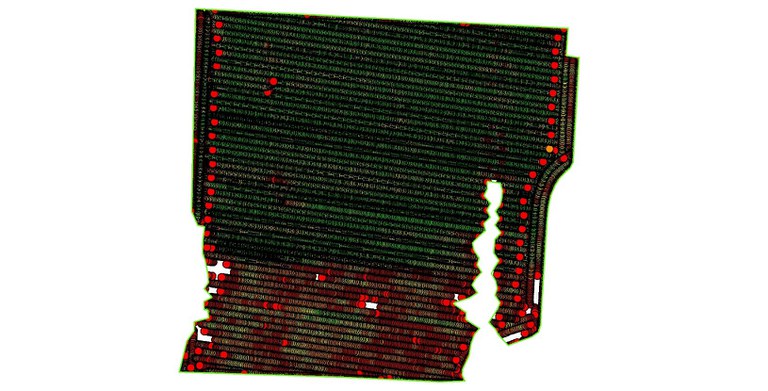 Figure 1: Typical yield map of a soybean field. The volumes in the data set range from 5–157 bushels per acre dry. In this example, it is clear that the lowest yields were found in the southernmost portions of the field. Field conditions can be quickly assessed throughout the season using sUAS imagery.
Figure 1: Typical yield map of a soybean field. The volumes in the data set range from 5–157 bushels per acre dry. In this example, it is clear that the lowest yields were found in the southernmost portions of the field. Field conditions can be quickly assessed throughout the season using sUAS imagery.
The next step is to generate a raster-based (image) surface from the points. While there are numerous ways to create these surfaces, for the purpose of this example I will simply utilize what is known as inverse-distance weighting (Figure 2). This is a traditional, yet still powerful method to create the surface, comprised of pixels much like a typical image. By creating an interpolated surface, we can use a variety of tools to calculate new values for each of the pixels. For example, if the pixel is 5m2 then the ground area that each pixel covers is 25 square meters. If the cost to plant one acre of soybean is $250.00, then each 5m2 pixel in the input surface would represent a cost of approximately $1.54 (4046.86 sq. meters in an acre).
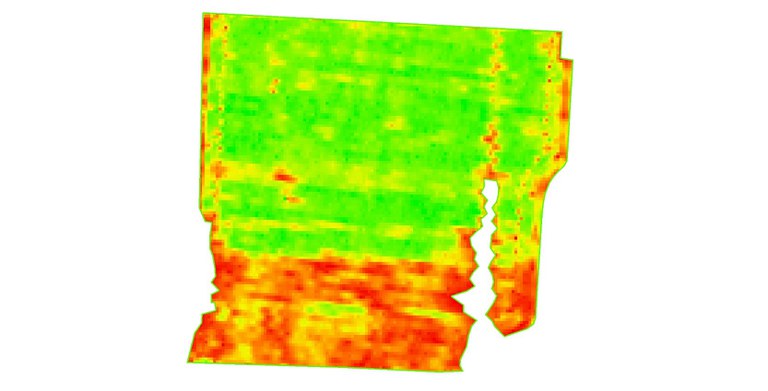 Figure 2: Interpolated surface from the input yield data, using a pixel size of 5m2.
Figure 2: Interpolated surface from the input yield data, using a pixel size of 5m2.
The process to move from the interpolated surface to an in-field profit map now consists of calculating the profit per cell (Figure 3). In terms of site-specific yields, we can answer questions such as “What areas of the field met or exceeded production goals?” or “What areas of the field generated the greatest profit this year?” When this information is combined with previous years, trends in profit or loss are evident. The basic formula to calculate profit is:
Profit = (Yield x Market Price) - Total Costs
While the equation used for the purpose of this article is relatively straightforward, there are numerous inputs that would affect total costs, for example. According to the USDA, the market price in North Dakota for soybean was $8.11 in August of 2020. For input costs we estimated $250.00/acre. These values would differ based on market prices, labor costs, etc. In addition to looking at in-field variability pertaining to profit, we can also look at how the cost per bushel varies across the field (Figure 4).
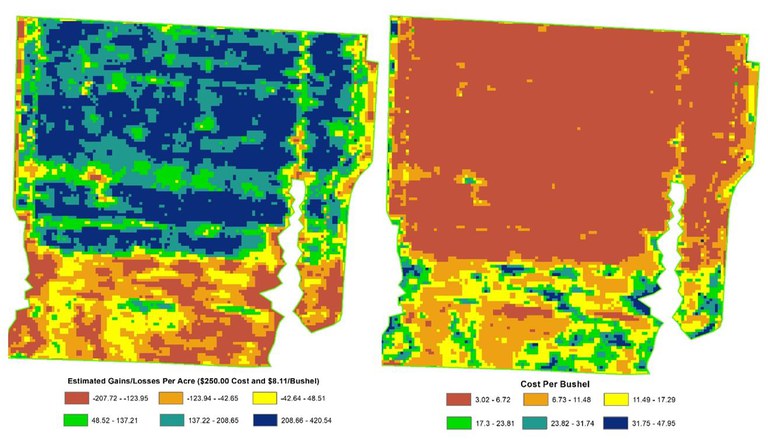 Figures 3 & 4: Estimated profit map utilizing 5m2 cells and in input cost of $250.00. According to the USDA the market price for a bushel of soybeans in August of 2020 was $8.11 in North Dakota. The greatest ROI is found in the northern 2/3 of this field. As expected, the lowest cost per bushel to produce is correlated with the areas of the field showing the highest profits.
Figures 3 & 4: Estimated profit map utilizing 5m2 cells and in input cost of $250.00. According to the USDA the market price for a bushel of soybeans in August of 2020 was $8.11 in North Dakota. The greatest ROI is found in the northern 2/3 of this field. As expected, the lowest cost per bushel to produce is correlated with the areas of the field showing the highest profits.
The use of GIS to analyze metrics such as profit and/or cost per bushel across a field represents a unique way to quantify a field’s performance beyond simple field averages. In some cases, shifting efforts to the more productive areas may have a significant impact on overall profit. Areas that offer low ROI may be better suited for other crops, or conversion to something like cover crops that may then be used for carbon offsets, for example.
Information for this article was obtained from the following sources:
USDA, “Agricultural Practices”. Released September 2020. ISSN: 1937-4216.
Murrell, T.S. and Rund, Q.B. “Using ArcGIS for Yield Data Analysis”. Proceedings of the ESRI International User Conference. 2003.
David Kramar, Ph.D.
David.Kramar@ndsu.edu
Precision Agriculture Specialist
John Nowatzki
NDSU Extension Emeritus – Agriculture and Biosystems Engineering


